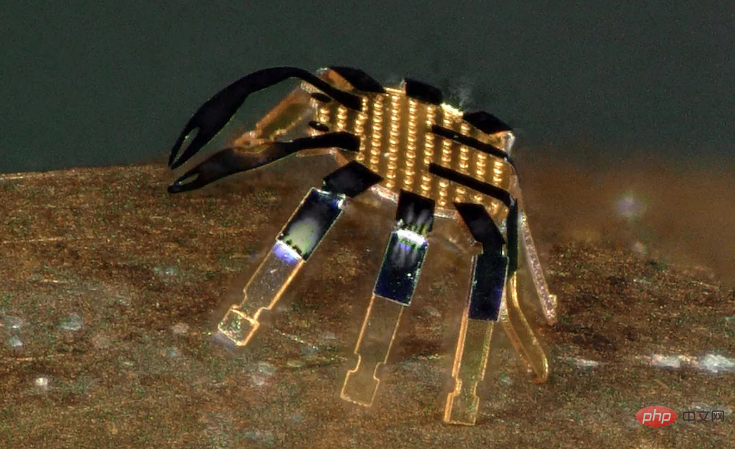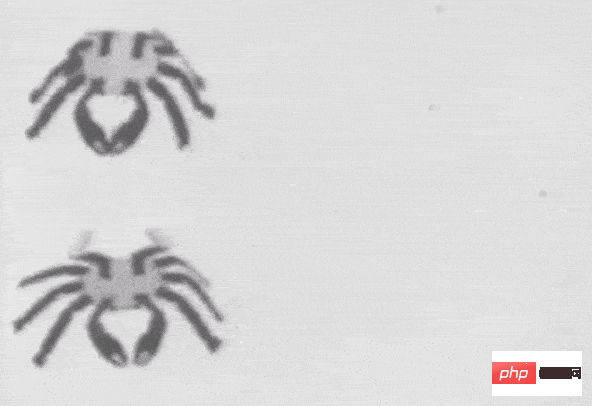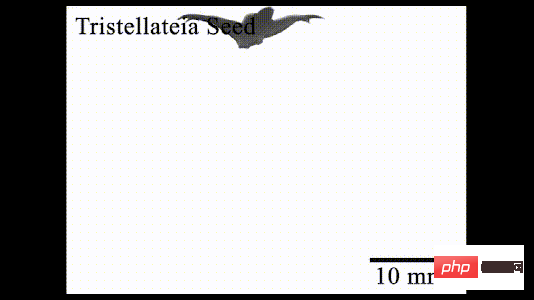

This "sideways walking" micro-robot is so cute!
The May issue of Science Robotics published a study by Northwestern University. This study introduces A sub-millimeter level multi-material land robot was developed.
According to reports, this robot is inspired by a crab. Its miniature size and flexible pace allow this small robot to walk freely on the edge of a coin while being remotely controlled.
In the future, this robot can be used for confined space operations and even minimally invasive surgeries.

Paper link:
https://www.science.org/doi/10.1126/scirobotics.abn0602.
From the appearance, this robot has 8 legs, a pair of pincers, a round body and a crab Very similar, it is indeed inspired by a crab - the "Peeping Toe Crab"
John A. Rogers, the lead researcher of this study, said that their work complements other The work of scientists working on millimeter-scale robots, for example, is a worm-like structure that can move through a liquid medium with flagella.
But as far as he knows, their crab microrobot is the smallest land robot, only half a millimeter wide, that can walk on solid surfaces in the open air.

The robot is composed of three key materials: an electronic-grade polymer for the body and limbs; and shape memory alloy (SMA) that forms the "moving" parts. ;There is also a thin layer of glass that acts as an exoskeleton to increase the rigidity of the structure.
Rogers added that they are not limited by these specialty materials, however, his team is looking at ways to integrate semiconductor materials and other types of conductors.
This tiny robot is able to move quickly due to the presence of shape memory alloy (SMA). This type of material undergoes a phase change at a certain temperature, causing a change in shape.
Rogers said: "So you create the material in an initial geometry, deform it, and then when you heat it, it goes back to the initial geometry... We use the shape change as some kind of mechanical actuator or The basis of some kind of muscle."

To get the memory metal to heat up, the researchers used a laser beam focused on the robot. "Whenever a laser beam illuminates the robot's shape memory alloy parts, it causes a phase change and corresponding motion," Rogers said. "When the laser beam is moved away, these parts are rapidly cooled and the limb It will return to the deformed geometry."
Therefore, laser spots scanning the robot's body can sequentially activate various joints to establish gait and direction of movement.
While this approach has its merits, Rogers wants to explore more options. "With lasers, you need some kind of optical access... (but) depending on where you want the robot to work, whether that's feasible or not," Rogers said.
Microrobotics Expert's Natural Philosophy
His lab has developed tiny structures that resemble worms and beetles, and even a winged microchip that moves passively through the air on the same principle that wind spreads seeds.
 In 2015, Rogers and his colleagues also published a paper on how to exploit the Japanese art of kirigami (such as that seen in pop-up books) They designed their robot based on the kirigami concept.
In 2015, Rogers and his colleagues also published a paper on how to exploit the Japanese art of kirigami (such as that seen in pop-up books) They designed their robot based on the kirigami concept.
They used high-fidelity, multilayer stacks of patterned materials supported by silicon wafers, but while these materials are useful for integrated circuits, they "are not good for robots," Rogers said, because they are flat. In order to bring them into the third dimension, studying the principles of Qi is a starting point.
As Rogers emphasized, their research is currently purely exploratory, trying to introduce some additional ideas into microrobotics engineering.
"We can move these robots and make them go in different directions, but they don't perform a specific task," he said.
For example, even though the crab robot has claws, these are only for visual purposes, they do not move or grasp objects. "Creating capabilities for mission execution will be the next step in research in this area," he said. Now, however, making multi-material 3D structures and using SMA for bidirectional actuation are two key parts of his team's contribution to wider research.
To explore further, he and his colleagues are considering how to increase the ability to grasp or manipulate objects at this scale and how to add microcircuitry, digital sensors and wireless communications to the robots. For example, communication between robots could allow them to work as a swarm. Another area for research is adding some kind of local power supply powered by photovoltaics, for example, to provide local heating via a microcontroller in a time-sequential manner to control movement.
In terms of potential applications, Rogers envisions microrobots being used for work in confined spaces, primarily for minimally invasive surgery, and to a lesser extent vehicles for making other micromachines. But he also advocates caution: "I don't want to overstate what we're doing. It's easy to fantasize about these robots going into the body and doing some powerful things medically. (But) that's where we want to be, and that's That’s what drives a lot of our work.”
Related coverage:
The above is the detailed content of Can walk on the edge of a coin! The smallest crab robot on land is launched and could be used for minimally invasive surgeries in the future. For more information, please follow other related articles on the PHP Chinese website!




